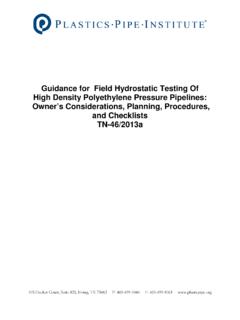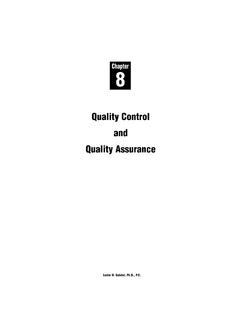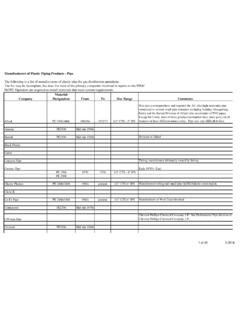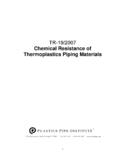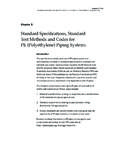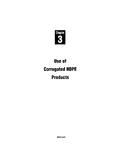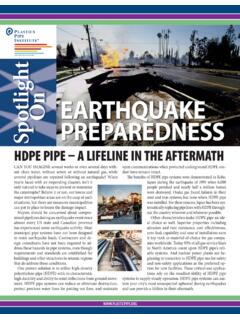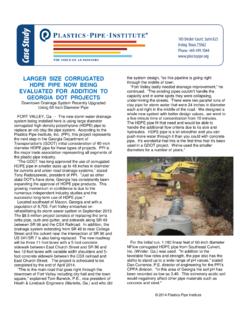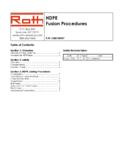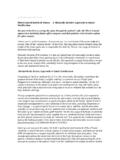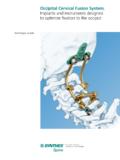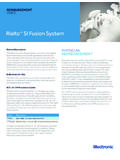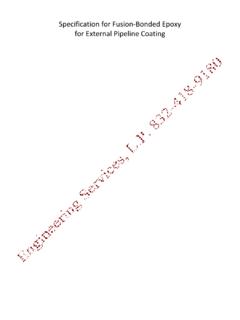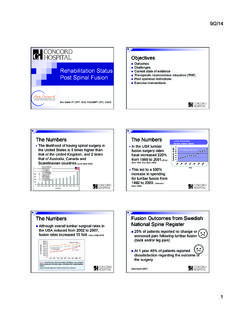Transcription of TN-51 Polyethylene Pipe Butt Fusion Structure, …
1 Polyethylene Pipe Butt Fusion Structure, Process, and Terminology TN-51 2018 Foreword ii Polyethylene PIPE BUTT Fusion STRUCTURE, PROCESS, AND TERMINOLOGY This report was developed and published with the technical help and financial support of the members of the PPI (Plastics Pipe Institute, Inc.). The members have shown their interest in quality products by assisting independent standards-making and user organizations in the development of standards, and also by developing reports on an industry-wide basis to help engineers, code officials, specifying groups, and users. This report has been prepared by PPI as a service of the industry.
2 The information in this report is offered in good faith and believed to be accurate at the time of its preparation, but is offered as is without any express or implied warranty, including WARRANTIES OF MERCHANTABILITY AND FITNESS FOR A PARTICULAR PURPOSE. Any reference to or testing of a particular proprietary product should not be construed as an endorsement by PPI, which does not endorse the proprietary products or processes of any manufacturer. The information in this report is offered for consideration by industry members in fulfilling their own compliance responsibilities. PPI assumes no responsibility for compliance with applicable laws and regulations.
3 PPI intends to revise this report from time to time, in response to comments and suggestions from users of the report. Please send suggestions of improvements to the address below. Information on other publications can be obtained by visiting the web site. The Plastics Pipe Institute, Inc. This Technical Note, TN-51 , was first issued in May 2017 and updated in August 2018. The Plastics Pipe Institute, Inc. 2018 iii Table of Contents Foreword .. i Polyethylene Pipe Butt Fusion Structure, Process, and Terminology .. 1 Fusion Bead Removal .. 7 APPENDIX .. 9 List of Figures Figure 1: Natural Color Polyethylene Pipe being Fused, 1959, in Caney, Kansas.
4 1 Figure 2: 12-inch IPS Pipe, DR 11, Fusion Joint Cross-section (ground flat) .. 3 Figure 3: 12-inch IPS Pipe, DR 11, Fusion Joint Cross-section, after Heat-Reversion .. 4 Figure 4: Axial Heating, Axial Conduction, Radial Melt-Flow, Plane of Co-Crystallization, Bead Structure .. 5 Figure 5: Seven (7) Zones within the Polyethylene Pipe Butt- Fusion .. 6 Figure 6: Heat-Reversion Machined Pipe Wall -- 36-in IPS DR 9 PE4710 Pipe Butt- Fusion Cross-Section, with larger melt bead-up lobes .. 8 Figure A 1: Interface Upon Wetting Contact (showing polymer molecular chains) ..10 Figure A 2: Autohesion Diffusion and Coalescence vanishes the interface ..10 Figure A 3: Diffusion Entanglement and Co-Crystallization into one bulk solid.
5 10 1 Polyethylene Pipe Butt Fusion Structure, Process, and Terminology The purpose of this Technical Note is to impart a basic understanding of the Fusion joint and its sub-structure, with the plane of co-crystallization across which the long Polyethylene molecules inter-diffuse (knit together) to form the full strength joint. The roll back beads are an indication of a correctly made butt- Fusion , however the actual joint is the plane of co-crystallization, which is centered between the dual beads. Butt- Fusion of Polyethylene plastic pipe was pioneered in the USA by industry founding fathers among whom are Ole Larsen, Bob Weaverling, Bud Bridenstine, John Merideth, Jean Louthan, Paul Petro, and others, most of whom began extruding and fusing Polyethylene pipe in 1958, as employees of Phillips Petroleum s oilfield Drilling Specialties Co.
6 (abbreviated initials: DRISCO), which evolved into Driscopipe in the late 1970 s. Drilling Specialties Co. made the first hand operated flat-heater plate Fusion machines heated by an acetylene torch with an embedded oven thermometer. Later an associate company was invited to assume the manufacture of Fusion equipment so DRISCO could focus on extrusion of high density Polyethylene pipe. As a result, today we all enjoy the benefit of quality Fusion machines across the world. Figure 1: Natural Color Polyethylene Pipe being Fused, 1959, in Caney, Kansas 2 The solid semi-crystalline Polyethylene material melts, technically, at about 257 F, and turns into an amorphous mass of variable length molecules, thermally mobilized by the applied heat energy.
7 As the temperature is further raised to 425 F, the polymer macro melt viscosity reduces, reflecting the increased molecular motion. As the constant temperature heater plate is left in contact with the face of the melting pipe, the crystalline portion of the HDPE chains un-fold , and the melt increases in volume by 28%. This explains the reason that a circular melt-bead forms around the perimeter of the pipe end on the flat heater plate, even though the Fusion machine pipe clamps are locked into position. The increase in volume has to go somewhere, so it is pushed out radially around the perimeter of the melt face. Obviously, with increasing pipe diameter and wall thickness, the melt-bead size increases.
8 With increasing contact time, the depth of melt increases, up to a certain axial limit. In the axial direction of the pipe, there exists a distance of thermal gradient from 425 F down to 73 F, which might be a total distance or axial depth of about inch to inch, depending upon the pipe diameter and wall thickness. From the melt face at 425 F along a short distance, the temperature drops to its crystallization / solidification temperature, at which point the Polyethylene is molten on one side and hot, but solid, on the other side; from there further along the axis of the pipe away from the heated end, the temperature drops to ambient temperature.
9 The flow viscosity of the Polyethylene melt is a function of its temperature. The 425 F Polyethylene melt flows more easily than at 350 F, than at 280 F. At 240 F, the Polyethylene is malleable, but solid, and does not flow . So, when the two melt faces are co-joined with axial force, the HDPE pipe face melt volume flows radially until the axial force, from the increasingly viscous flow resistance of the variable temperature melt depth, equals the applied hydraulic force. From there, the hydraulic pressure remains applied and the clamps moveable, to compensate for additional axial thermal contraction as the hot melt mass thermally contracts during cooling.
10 If the clamps became locked after initial bead formation, the thermal contraction of the melt volume could pull the interface apart, partially or totally; so the clamps have to move with the axial melt shrinkage. Figure 2 illustrates the cross-section of a 12-inch IPS DR 11 fully formed flat heater plate butt- Fusion s outer (top) and inner (bottom) beads. The OD bead is typically tight to the OD of the pipe, because the outward radial melt flow is formed in tension, which tends to pull the melt bead backwards to the pipe OD. The ID bead melt flow is formed in circumferential compression as its formation decreases the ID, which tends to push the bead off the ID pipe wall.
